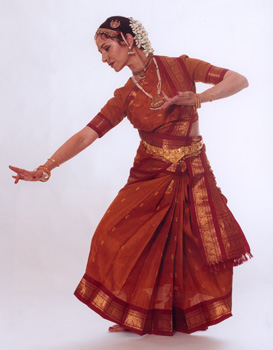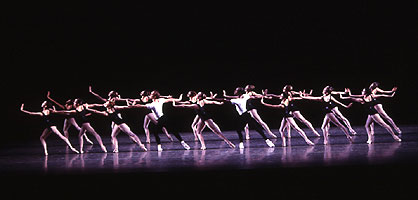6.) Comparing Ballet as a Form of Ethnic (Classical) Dance with Bharata Natyam
 Introduction:
Introduction:
In the last session, students challenged personal viewpoints of beauty in dance and movement by “makingthe familiar strange and the strange familiar.” Students increased awareness of our own cultural practices, contemplating on how they might appear strange to someone else and that someone else's practices might seem strange to us as we both struggle to make sense of what we see. Students practiced objective viewing to tease out the intrinsic features or dance elements of a choreographic work and discerned form (features) from meaning (context). Ultimately, students learned that meaning and evaluation, in dance and life, depend on context.
Today, students explore the idea of universals in dance to bring out the way dance/movement is woven through with other aspects of culture: environment, material culture, language, kinship and social networks, subsistence patterns and economic networks, systems of power, play, health and healing, and change.
Classroom activities:
- Discuss articles read as homework: Coles and Beck and Walters. Focus the discussion on the similarities and differences of the intrinsic and extrinsic features described in each article.
- Show George Balanchine's Four Temperaments (duo) video clips. Make a lexicon word lists to capture features of the dances viewed.
- Facilitate a discussion and organize dance element responses for all to view. Ask guiding questions:
- What do you see? What stands out to you?
- How is this like/unlike the Pueblo Parrot dance? Rennie Harris’ Students of the Asphalt Jungle? Madonna’s voguing? Again, suggest comparison with dances previously viewed to bring out details, e.g., duet, touch, multiple shapes, constant change, bare bodies, pointed toes, codified technique, virtuosity.
- Compare the setting and context as well as the formal elements of the dancing. In what social setting is this done? Who dances? Who doesn't dance? What are the non-performing roles (producers, audience, ushers, critics, etc.)?
- Read Denby and Croce excerpts from Ann Daly’s, “Hummingbirds” aloud.
- Shift discussion to Universals of Culture (environment and material culture, language, kinship and social networks, subsistence patterns and economic networks, systems of power, play, health and healing and change) making the point that the way dance/movement is woven through with other aspects of culture. Discuss the meaning or working definition of each point.
- Create a web on the board illustrating the ways the universals come into play for the Balanchine ballet. Cite examples in each strand:
- Environment and material culture: discuss dance studios and theatres, outfits required for classes, rehearsals, performance, and the like.
- Subsistence patterns and economics: discuss ballet as profession, patronage, cost of tickets, networks for sustaining support of ballet, and the like. Also, discuss audience's 9-5 work schedules and separation of "play time."
- Language -- English, but also the vernacular, French-derived "language" of ballet.
- Discuss context of the ballet viewed in relation to Pueblo Parrot dance, Rennie Harris’ Students of the Asphalt Jungle and Madonna’s voguing video. Facilitate guiding questions:
- What is the purpose of this dance in its socio-cultural context?
- Why do people do it?
- What are its effects?
- What is its "meaning" for those who participate at all levels?
- What ideals (especially of beauty) and values are being expressed? Do you share them?
- Where is the individuality and agency in this dance? (In what ways is this not about individuality/virtuosity, but about conformity?)
- How do dances change and respond to historical circumstances?
- Segue to introduce another classical form of dance and encourage students to make similarities with and differences from the Balanchine duo. View videoclip of bharatanatyam, a solo performed by Malavika Sarubai. [As preparation, the class or instructor might read Avanthi Meduri’s World Encyclopedia of Dance article on bharatanatyam or Jonas.]
- After viewing the videoclip, make a lexicon together with the class. Prompt discussion with: What do you see? What stands out to you? How is this like and unlike the Balanchine?
- Facilitate discussion based on the earlier homework readings and class discussions. Consider ballet and bharatanatyam as classical forms related to different, especially religious and historical contexts. Ask these guiding questions:
- Is it possible to understand or appreciate the beauty of a form without knowledge of these contexts?
- How might a critic from one culture review a work from a different cultural tradition?
Closing:
 To end class, discuss how cultural universals bring out the way dance/movement is woven through with other aspects of culture. Observers can choose to look through the lens(es) of environment, material culture, language, kinship and social networks, subsistence patterns and economic networks, systems of power, play, health and healing and change to deepen understanding. Students might write reflectively about today’s session, discussing: What influences my choice of lexicons when I view dance? Art? Music videos? Etc.
To end class, discuss how cultural universals bring out the way dance/movement is woven through with other aspects of culture. Observers can choose to look through the lens(es) of environment, material culture, language, kinship and social networks, subsistence patterns and economic networks, systems of power, play, health and healing and change to deepen understanding. Students might write reflectively about today’s session, discussing: What influences my choice of lexicons when I view dance? Art? Music videos? Etc.
Homework: Explain final project choices
Final Project: create a term project, choosing from among the following:
- A three minute slide show or film revealing how dance/movement elements (shape, space, etc.) relate to environment in everyday life, demonstrating the connection between form and context. Students may also choose to take on the challenge of "making the strange familiar," showing an everyday setting in a Nacirema-like light.
- A one-to-two minute dance/movement study that comments upon (rather than simply displays) a dance or movement genre. Here, "commenting upon" implies bringing out the function, meaning, or values implicit in the genre. You might do this by exaggerating certain features, juxtaposing different kinds of movement or text with movement, etc.
- A three page essay drawing on one or more dance/movement forms to develop an idea based on or stimulated by the course. Feel free to include various rhetorical strategies in presenting your ideas (such as poetry or letter form, mock or real scholarly paper, drawings, graphs, illustrations, photos, and the like. Illustrations do not count as part of the three pages.

